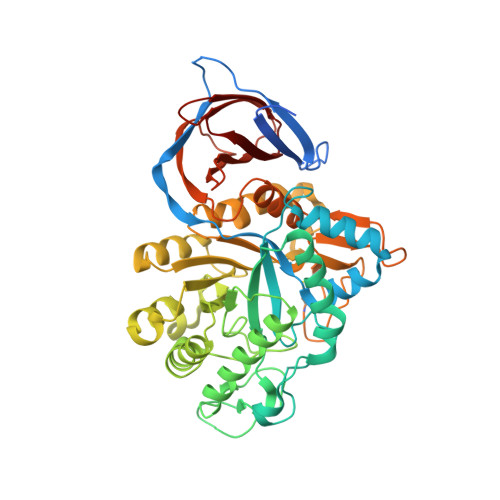A Bacteroidetes locus dedicated to fungal 1,6-beta-glucan degradation: Unique substrate conformation drives specificity of the key endo-1,6-beta-glucanase.
Temple, M.J., Cuskin, F., Basle, A., Hickey, N., Speciale, G., Williams, S.J., Gilbert, H.J., Lowe, E.C.(2017) J Biological Chem 292: 10639-10650
- PubMed: 28461332
- DOI: https://doi.org/10.1074/jbc.M117.787606
- Primary Citation of Related Structures:
5NGK, 5NGL - PubMed Abstract:
Glycans are major nutrients available to the human gut microbiota. The Bacteroides are generalist glycan degraders, and this function is mediated largely by polysaccharide utilization loci (PULs). The genomes of several Bacteroides species contain a PUL, PUL 1,6-β-glucan , that was predicted to target mixed linked plant 1,3;1,4-β-glucans. To test this hypothesis we characterized the proteins encoded by this locus in Bacteroides thetaiotaomicron , a member of the human gut microbiota. We show here that PUL 1,6-β-glucan does not orchestrate the degradation of a plant polysaccharide but targets a fungal cell wall glycan, 1,6-β-glucan, which is a growth substrate for the bacterium. The locus is up-regulated by 1,6-β-glucan and encodes two enzymes, a surface endo-1,6-β-glucanase, BT3312, and a periplasmic β-glucosidase that targets primarily 1,6-β-glucans. The non-catalytic proteins encoded by PUL 1,6-β-glucan target 1,6-β-glucans and comprise a surface glycan-binding protein and a SusD homologue that delivers glycans to the outer membrane transporter. We identified the central role of the endo-1,6-β-glucanase in 1,6-β-glucan depolymerization by deleting bt3312 , which prevented the growth of B. thetaiotaomicron on 1,6-β-glucan. The crystal structure of BT3312 in complex with β-glucosyl-1,6-deoxynojirimycin revealed a TIM barrel catalytic domain that contains a deep substrate-binding cleft tailored to accommodate the hook-like structure adopted by 1,6-β-glucan. Specificity is driven by the complementarity of the enzyme active site cleft and the conformation of the substrate. We also noted that PUL 1,6-β-glucan is syntenic to many PULs from other Bacteroidetes, suggesting that utilization of yeast and fungal cell wall 1,6-β-glucans is a widespread adaptation within the human microbiota.
- From the Institute of Cell and Molecular Biosciences, Newcastle University, Newcastle upon Tyne NE4 2HH, United Kingdom and.
Organizational Affiliation:
















